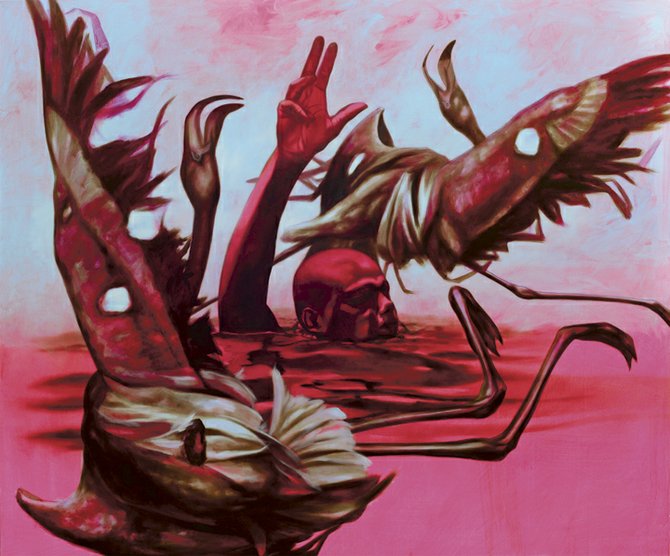Artist Kishan Munroe is set to open a multi- disciplinary exhibition later this month at the National Art Gallery of The Bahamas that will be transformative in both its scope and scale.
“Swan Song of the Flamingo” is a collaborative project that marries Munroe’s visual artistry with the work of other Bahamian and Cuban artists from various disciplines to shine a spotlight on a painful period in Bahamian history in a boundary shattering way.
Munroe has recruited Bahamian artists like Patricia Glinton Meicholas, Gavin McKinney, Obediah Michael Smith, Joann Callender, Cleophas Adderley, Sonia Farmer, Lee Callender and Cuban dancers Eduardo Blanco, Amaya Rodriquez to lend their talents to the project that memorialises the sinking of HMBS Flamingo of the Royal Bahamas Defence Force fleet on May 10, 1980. He also worked closely with the Royal Bahamas Defence Force to bring this project to life.
Through a mix of visual, audio and literary arts, Munroe and some of Cuba’s and the Bahamas’ most well known and influential artists weave together the fibers of a story that addresses the historical and cultural nuances that have shaped Bahamian culture and its relationship to Cuba.
“Swan Song of the Flamingo” will demand critical analysis from its audience as it contextualizes the Bahamas and the loss of the Flamingo within the global drama that was the Cold War as well as the geo-political drama that was, and still is, the tenuous relationship between the United States and Cuba.
What is offered by Munroe and his collaborators is not a bitter reflection on the events of the past but, for the first time ever, an analytical investigation into the incident.
The “Swan Song of the Flamingo” represents an impressive effort on Munroe’s part, displaying his artistry, his interest in regional and Bahamian history and is a testament to his work as a tireless cataloger of the trials and triumphs of the people of the Americas.
The driving force behind the project, Munroe approached both the Cuban and Bahamian governments, explaining that he intends for the project to foster a broader dialogue between the nations and their leaders and citizens alike.
For almost three years, Munroe travelled between both countries engaging in dialogue with embassies, government officials and those affected by the tragedy.
Kishan is the youngest artist to be granted a solo exhibition at The National Art Gallery of The Bahamas but thought that the historical magnitude of this incident necessitated broad collaboration.
“Swan Song of the Flamingo” opens on November 21 at The National Art Gallery of the Bahamas and runs for four months.
ABOUT THE HMBS FLAMINGO
In the history of the Commonwealth of the Bahamas following the country’s independence, the only act of invasion of the archipelago’s territorial space and attack on the country’s military forces was committed by the Cuban air force in 1980. Precipitated by the Royal Bahamas Defense Force’s HMBS Flamingo’s arrest of two Cuban vessels for illegally fishing in Bahamian waters, the encounter would turn out to be a tragic territorial conflict. In an apparent act of retaliation, Cuban air fighters breached Bahamian airspace, eventually sinking the HMBS Flamingo, and killing 4 of its 19 crewmen.
This brief but devastating encounter was most likely the result of a lack of agreed territorial demarcations. Blurred borders mixed with blood, the thin line of life and death clearly crossed. Balance for a tender moment was clumsily lost on an undrawn line. Ever since, the Bahamas has commemorated the fallen marines of HMBS Flamingo annually on May 10.
Despite this unfortunate incident both countries have sustained favourable social and political relations since that time. Recently, Cuba and the Bahamas signed a delimitation of the maritime boundaries agreement, specifying the national borders of both countries. This was the first treaty of its kind ever signed by the Commonwealth of the Bahamas. Both countries continue to exchange human and commercial resources, remaining in close relation despite negative political influences. This evidences the power of the logical and emotive human mind to move beyond tragedy, recognising the process of reconciliation as key to the redemption of neighbourliness and the sustaining of a peaceful coexistence.





Comments
Use the comment form below to begin a discussion about this content.
Sign in to comment
Or login with:
OpenID